Research Report: Critical Review of Smoking and Periodontal Health
VerifiedAdded on 2020/01/28
|8
|2300
|108
Report
AI Summary
This report offers a critical evaluation of a research article that investigates the impact of smoking on periodontal health. The article, employing a qualitative study with primary research methods, explores the relationship between smoking and the development of periodontal diseases. The analysis includes an assessment of the article's introduction, methods, results, and discussion sections. The study utilizes various techniques, including computerized randomization, clinical parameter measurements (plaque index, gingival index), and statistical analysis (Mann-Whitney test, Spearman correlation coefficient). The findings indicate a correlation between smoking and higher levels of bleeding, probing depth, and clinical attachment loss. The report also discusses the limitations of the study and its future scope, emphasizing the potential for further research into the influence of smoking on periodontal health. The study's conclusion highlights the importance of the research findings and the methodologies used in presenting the results, making it a valuable resource for medical students and healthcare professionals. The research article is well-structured and the findings are presented in tabular form.
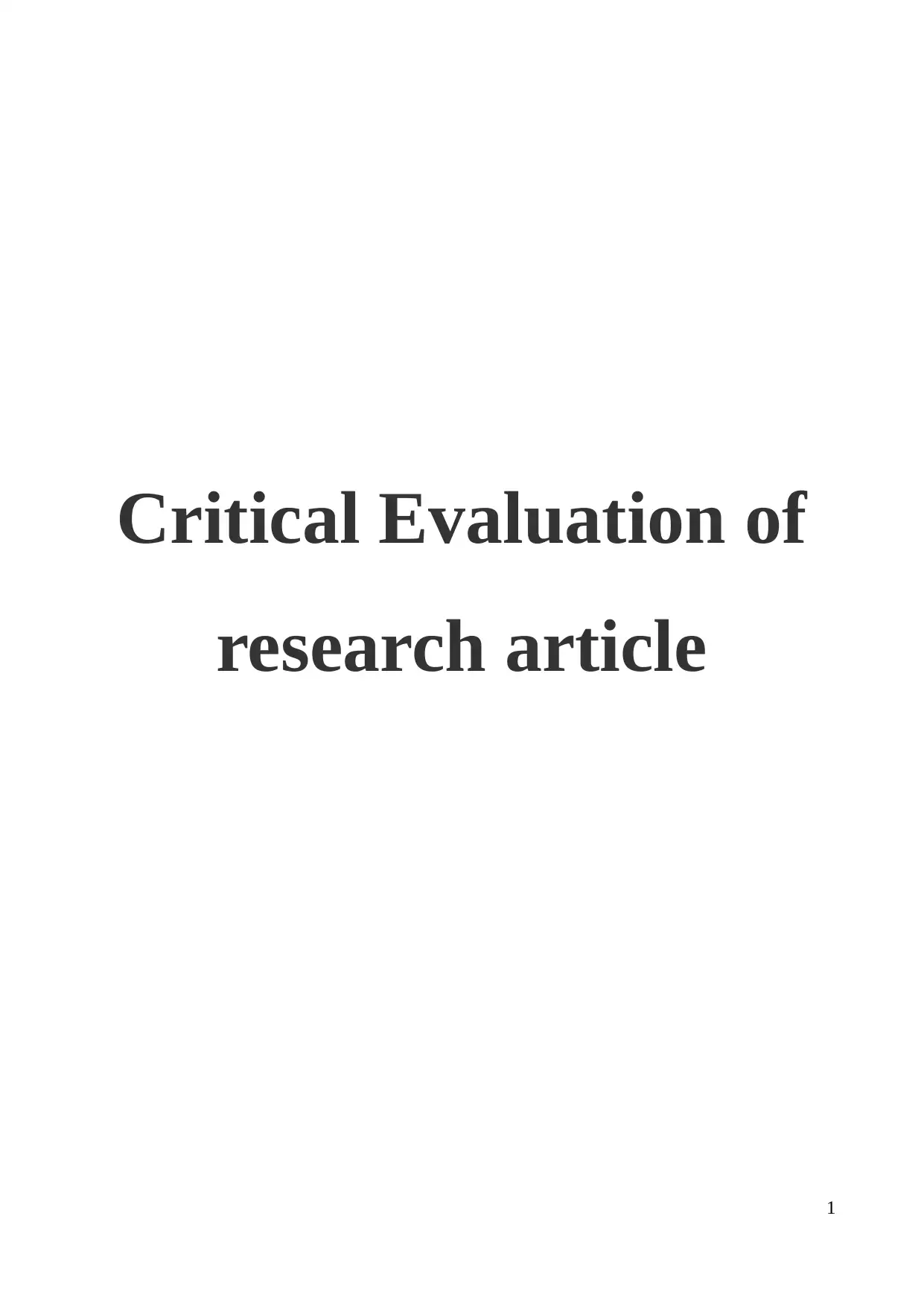
Critical Evaluation of
research article
1
research article
1
Paraphrase This Document
Need a fresh take? Get an instant paraphrase of this document with our AI Paraphraser

Table of Contents
INTRODUCTION ...............................................................................................................................4
Introduction of the article ...............................................................................................................4
Methods ..........................................................................................................................................4
Results .............................................................................................................................................5
Discussion........................................................................................................................................6
Overview .........................................................................................................................................6
CONCLUSION ...................................................................................................................................7
References............................................................................................................................................8
2
INTRODUCTION ...............................................................................................................................4
Introduction of the article ...............................................................................................................4
Methods ..........................................................................................................................................4
Results .............................................................................................................................................5
Discussion........................................................................................................................................6
Overview .........................................................................................................................................6
CONCLUSION ...................................................................................................................................7
References............................................................................................................................................8
2
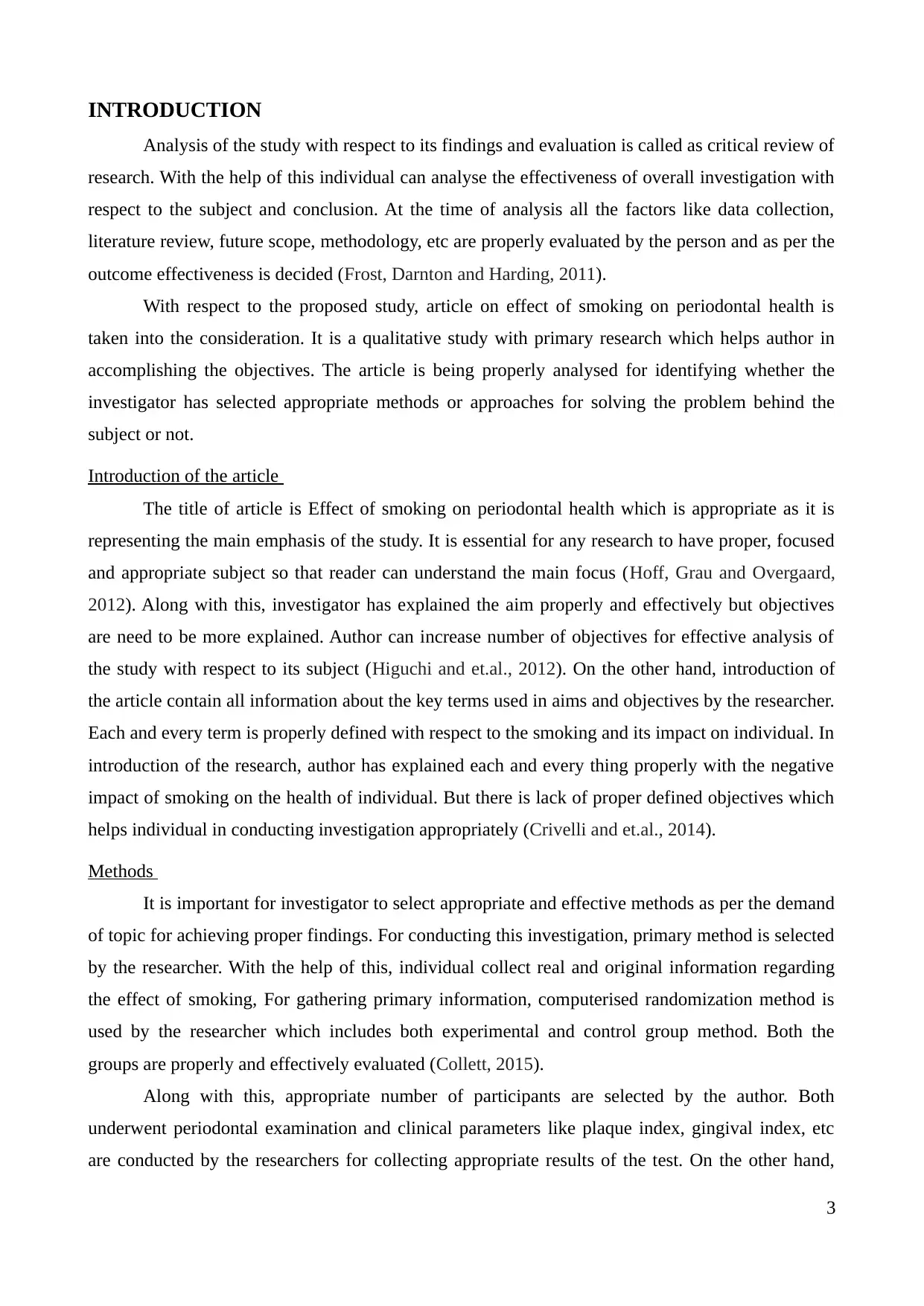
INTRODUCTION
Analysis of the study with respect to its findings and evaluation is called as critical review of
research. With the help of this individual can analyse the effectiveness of overall investigation with
respect to the subject and conclusion. At the time of analysis all the factors like data collection,
literature review, future scope, methodology, etc are properly evaluated by the person and as per the
outcome effectiveness is decided (Frost, Darnton and Harding, 2011).
With respect to the proposed study, article on effect of smoking on periodontal health is
taken into the consideration. It is a qualitative study with primary research which helps author in
accomplishing the objectives. The article is being properly analysed for identifying whether the
investigator has selected appropriate methods or approaches for solving the problem behind the
subject or not.
Introduction of the article
The title of article is Effect of smoking on periodontal health which is appropriate as it is
representing the main emphasis of the study. It is essential for any research to have proper, focused
and appropriate subject so that reader can understand the main focus (Hoff, Grau and Overgaard,
2012). Along with this, investigator has explained the aim properly and effectively but objectives
are need to be more explained. Author can increase number of objectives for effective analysis of
the study with respect to its subject (Higuchi and et.al., 2012). On the other hand, introduction of
the article contain all information about the key terms used in aims and objectives by the researcher.
Each and every term is properly defined with respect to the smoking and its impact on individual. In
introduction of the research, author has explained each and every thing properly with the negative
impact of smoking on the health of individual. But there is lack of proper defined objectives which
helps individual in conducting investigation appropriately (Crivelli and et.al., 2014).
Methods
It is important for investigator to select appropriate and effective methods as per the demand
of topic for achieving proper findings. For conducting this investigation, primary method is selected
by the researcher. With the help of this, individual collect real and original information regarding
the effect of smoking, For gathering primary information, computerised randomization method is
used by the researcher which includes both experimental and control group method. Both the
groups are properly and effectively evaluated (Collett, 2015).
Along with this, appropriate number of participants are selected by the author. Both
underwent periodontal examination and clinical parameters like plaque index, gingival index, etc
are conducted by the researchers for collecting appropriate results of the test. On the other hand,
3
Analysis of the study with respect to its findings and evaluation is called as critical review of
research. With the help of this individual can analyse the effectiveness of overall investigation with
respect to the subject and conclusion. At the time of analysis all the factors like data collection,
literature review, future scope, methodology, etc are properly evaluated by the person and as per the
outcome effectiveness is decided (Frost, Darnton and Harding, 2011).
With respect to the proposed study, article on effect of smoking on periodontal health is
taken into the consideration. It is a qualitative study with primary research which helps author in
accomplishing the objectives. The article is being properly analysed for identifying whether the
investigator has selected appropriate methods or approaches for solving the problem behind the
subject or not.
Introduction of the article
The title of article is Effect of smoking on periodontal health which is appropriate as it is
representing the main emphasis of the study. It is essential for any research to have proper, focused
and appropriate subject so that reader can understand the main focus (Hoff, Grau and Overgaard,
2012). Along with this, investigator has explained the aim properly and effectively but objectives
are need to be more explained. Author can increase number of objectives for effective analysis of
the study with respect to its subject (Higuchi and et.al., 2012). On the other hand, introduction of
the article contain all information about the key terms used in aims and objectives by the researcher.
Each and every term is properly defined with respect to the smoking and its impact on individual. In
introduction of the research, author has explained each and every thing properly with the negative
impact of smoking on the health of individual. But there is lack of proper defined objectives which
helps individual in conducting investigation appropriately (Crivelli and et.al., 2014).
Methods
It is important for investigator to select appropriate and effective methods as per the demand
of topic for achieving proper findings. For conducting this investigation, primary method is selected
by the researcher. With the help of this, individual collect real and original information regarding
the effect of smoking, For gathering primary information, computerised randomization method is
used by the researcher which includes both experimental and control group method. Both the
groups are properly and effectively evaluated (Collett, 2015).
Along with this, appropriate number of participants are selected by the author. Both
underwent periodontal examination and clinical parameters like plaque index, gingival index, etc
are conducted by the researchers for collecting appropriate results of the test. On the other hand,
3
⊘ This is a preview!⊘
Do you want full access?
Subscribe today to unlock all pages.

Trusted by 1+ million students worldwide
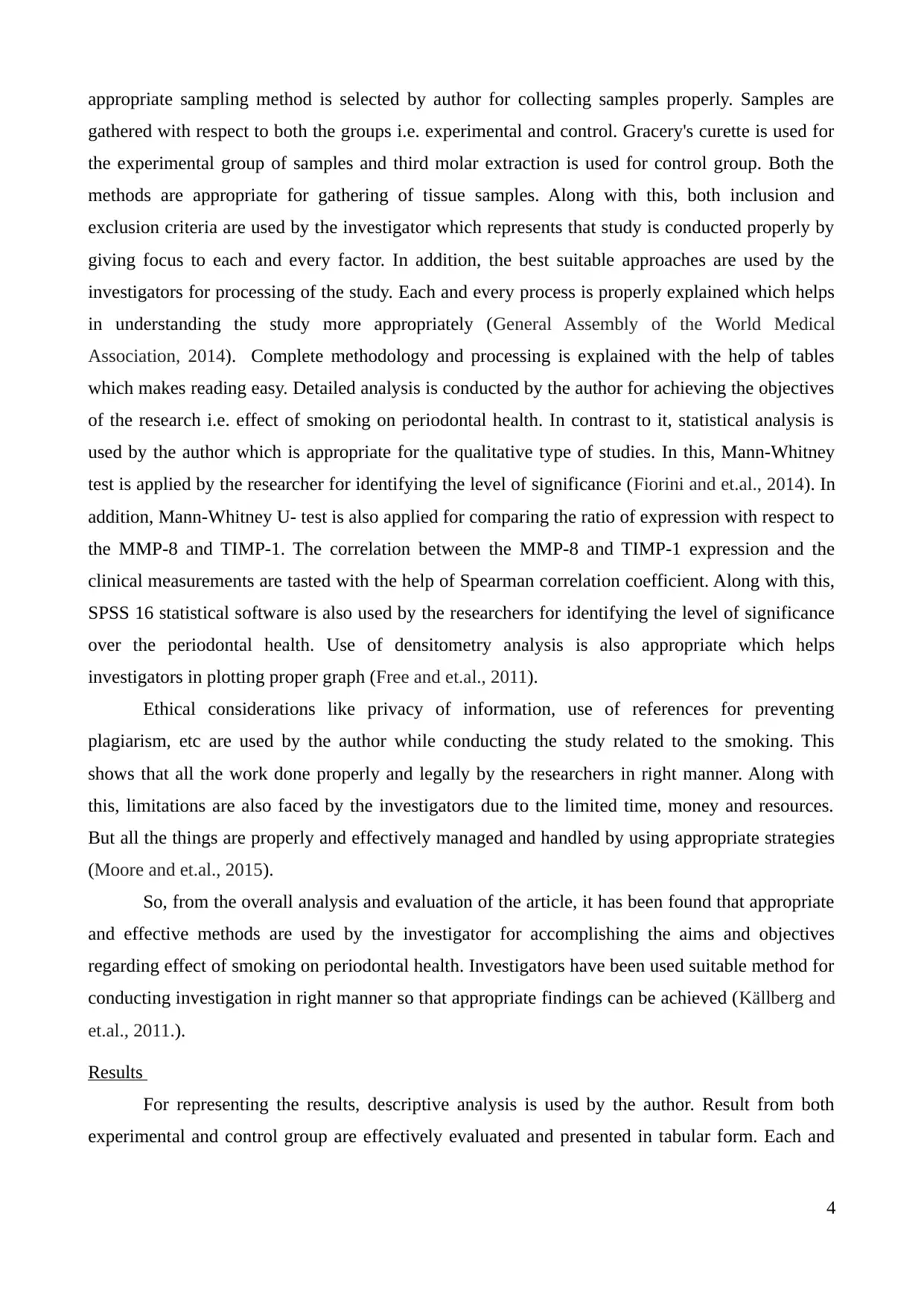
appropriate sampling method is selected by author for collecting samples properly. Samples are
gathered with respect to both the groups i.e. experimental and control. Gracery's curette is used for
the experimental group of samples and third molar extraction is used for control group. Both the
methods are appropriate for gathering of tissue samples. Along with this, both inclusion and
exclusion criteria are used by the investigator which represents that study is conducted properly by
giving focus to each and every factor. In addition, the best suitable approaches are used by the
investigators for processing of the study. Each and every process is properly explained which helps
in understanding the study more appropriately (General Assembly of the World Medical
Association, 2014). Complete methodology and processing is explained with the help of tables
which makes reading easy. Detailed analysis is conducted by the author for achieving the objectives
of the research i.e. effect of smoking on periodontal health. In contrast to it, statistical analysis is
used by the author which is appropriate for the qualitative type of studies. In this, Mann-Whitney
test is applied by the researcher for identifying the level of significance (Fiorini and et.al., 2014). In
addition, Mann-Whitney U- test is also applied for comparing the ratio of expression with respect to
the MMP-8 and TIMP-1. The correlation between the MMP-8 and TIMP-1 expression and the
clinical measurements are tasted with the help of Spearman correlation coefficient. Along with this,
SPSS 16 statistical software is also used by the researchers for identifying the level of significance
over the periodontal health. Use of densitometry analysis is also appropriate which helps
investigators in plotting proper graph (Free and et.al., 2011).
Ethical considerations like privacy of information, use of references for preventing
plagiarism, etc are used by the author while conducting the study related to the smoking. This
shows that all the work done properly and legally by the researchers in right manner. Along with
this, limitations are also faced by the investigators due to the limited time, money and resources.
But all the things are properly and effectively managed and handled by using appropriate strategies
(Moore and et.al., 2015).
So, from the overall analysis and evaluation of the article, it has been found that appropriate
and effective methods are used by the investigator for accomplishing the aims and objectives
regarding effect of smoking on periodontal health. Investigators have been used suitable method for
conducting investigation in right manner so that appropriate findings can be achieved (Källberg and
et.al., 2011.).
Results
For representing the results, descriptive analysis is used by the author. Result from both
experimental and control group are effectively evaluated and presented in tabular form. Each and
4
gathered with respect to both the groups i.e. experimental and control. Gracery's curette is used for
the experimental group of samples and third molar extraction is used for control group. Both the
methods are appropriate for gathering of tissue samples. Along with this, both inclusion and
exclusion criteria are used by the investigator which represents that study is conducted properly by
giving focus to each and every factor. In addition, the best suitable approaches are used by the
investigators for processing of the study. Each and every process is properly explained which helps
in understanding the study more appropriately (General Assembly of the World Medical
Association, 2014). Complete methodology and processing is explained with the help of tables
which makes reading easy. Detailed analysis is conducted by the author for achieving the objectives
of the research i.e. effect of smoking on periodontal health. In contrast to it, statistical analysis is
used by the author which is appropriate for the qualitative type of studies. In this, Mann-Whitney
test is applied by the researcher for identifying the level of significance (Fiorini and et.al., 2014). In
addition, Mann-Whitney U- test is also applied for comparing the ratio of expression with respect to
the MMP-8 and TIMP-1. The correlation between the MMP-8 and TIMP-1 expression and the
clinical measurements are tasted with the help of Spearman correlation coefficient. Along with this,
SPSS 16 statistical software is also used by the researchers for identifying the level of significance
over the periodontal health. Use of densitometry analysis is also appropriate which helps
investigators in plotting proper graph (Free and et.al., 2011).
Ethical considerations like privacy of information, use of references for preventing
plagiarism, etc are used by the author while conducting the study related to the smoking. This
shows that all the work done properly and legally by the researchers in right manner. Along with
this, limitations are also faced by the investigators due to the limited time, money and resources.
But all the things are properly and effectively managed and handled by using appropriate strategies
(Moore and et.al., 2015).
So, from the overall analysis and evaluation of the article, it has been found that appropriate
and effective methods are used by the investigator for accomplishing the aims and objectives
regarding effect of smoking on periodontal health. Investigators have been used suitable method for
conducting investigation in right manner so that appropriate findings can be achieved (Källberg and
et.al., 2011.).
Results
For representing the results, descriptive analysis is used by the author. Result from both
experimental and control group are effectively evaluated and presented in tabular form. Each and
4
Paraphrase This Document
Need a fresh take? Get an instant paraphrase of this document with our AI Paraphraser
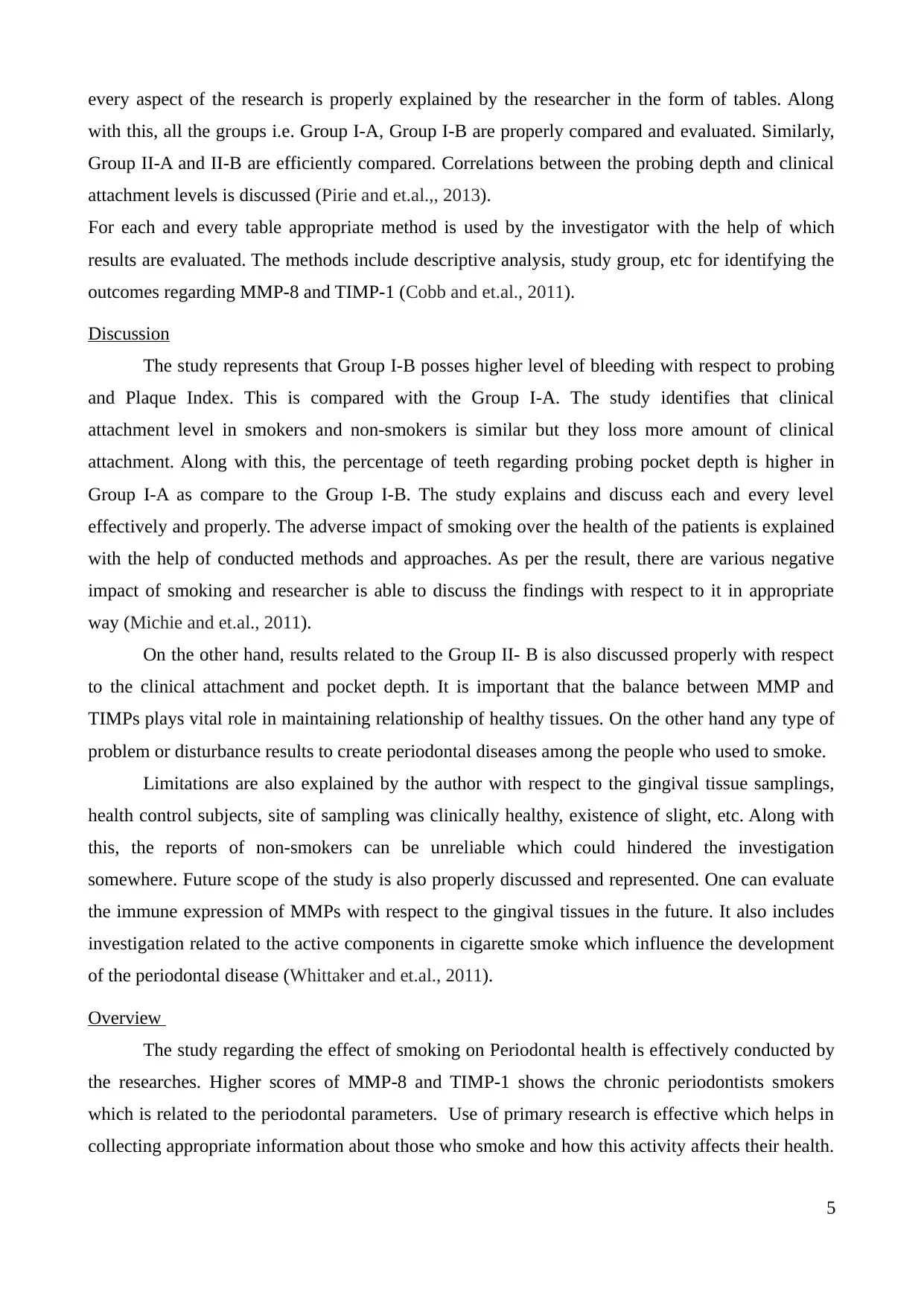
every aspect of the research is properly explained by the researcher in the form of tables. Along
with this, all the groups i.e. Group I-A, Group I-B are properly compared and evaluated. Similarly,
Group II-A and II-B are efficiently compared. Correlations between the probing depth and clinical
attachment levels is discussed (Pirie and et.al.,, 2013).
For each and every table appropriate method is used by the investigator with the help of which
results are evaluated. The methods include descriptive analysis, study group, etc for identifying the
outcomes regarding MMP-8 and TIMP-1 (Cobb and et.al., 2011).
Discussion
The study represents that Group I-B posses higher level of bleeding with respect to probing
and Plaque Index. This is compared with the Group I-A. The study identifies that clinical
attachment level in smokers and non-smokers is similar but they loss more amount of clinical
attachment. Along with this, the percentage of teeth regarding probing pocket depth is higher in
Group I-A as compare to the Group I-B. The study explains and discuss each and every level
effectively and properly. The adverse impact of smoking over the health of the patients is explained
with the help of conducted methods and approaches. As per the result, there are various negative
impact of smoking and researcher is able to discuss the findings with respect to it in appropriate
way (Michie and et.al., 2011).
On the other hand, results related to the Group II- B is also discussed properly with respect
to the clinical attachment and pocket depth. It is important that the balance between MMP and
TIMPs plays vital role in maintaining relationship of healthy tissues. On the other hand any type of
problem or disturbance results to create periodontal diseases among the people who used to smoke.
Limitations are also explained by the author with respect to the gingival tissue samplings,
health control subjects, site of sampling was clinically healthy, existence of slight, etc. Along with
this, the reports of non-smokers can be unreliable which could hindered the investigation
somewhere. Future scope of the study is also properly discussed and represented. One can evaluate
the immune expression of MMPs with respect to the gingival tissues in the future. It also includes
investigation related to the active components in cigarette smoke which influence the development
of the periodontal disease (Whittaker and et.al., 2011).
Overview
The study regarding the effect of smoking on Periodontal health is effectively conducted by
the researches. Higher scores of MMP-8 and TIMP-1 shows the chronic periodontists smokers
which is related to the periodontal parameters. Use of primary research is effective which helps in
collecting appropriate information about those who smoke and how this activity affects their health.
5
with this, all the groups i.e. Group I-A, Group I-B are properly compared and evaluated. Similarly,
Group II-A and II-B are efficiently compared. Correlations between the probing depth and clinical
attachment levels is discussed (Pirie and et.al.,, 2013).
For each and every table appropriate method is used by the investigator with the help of which
results are evaluated. The methods include descriptive analysis, study group, etc for identifying the
outcomes regarding MMP-8 and TIMP-1 (Cobb and et.al., 2011).
Discussion
The study represents that Group I-B posses higher level of bleeding with respect to probing
and Plaque Index. This is compared with the Group I-A. The study identifies that clinical
attachment level in smokers and non-smokers is similar but they loss more amount of clinical
attachment. Along with this, the percentage of teeth regarding probing pocket depth is higher in
Group I-A as compare to the Group I-B. The study explains and discuss each and every level
effectively and properly. The adverse impact of smoking over the health of the patients is explained
with the help of conducted methods and approaches. As per the result, there are various negative
impact of smoking and researcher is able to discuss the findings with respect to it in appropriate
way (Michie and et.al., 2011).
On the other hand, results related to the Group II- B is also discussed properly with respect
to the clinical attachment and pocket depth. It is important that the balance between MMP and
TIMPs plays vital role in maintaining relationship of healthy tissues. On the other hand any type of
problem or disturbance results to create periodontal diseases among the people who used to smoke.
Limitations are also explained by the author with respect to the gingival tissue samplings,
health control subjects, site of sampling was clinically healthy, existence of slight, etc. Along with
this, the reports of non-smokers can be unreliable which could hindered the investigation
somewhere. Future scope of the study is also properly discussed and represented. One can evaluate
the immune expression of MMPs with respect to the gingival tissues in the future. It also includes
investigation related to the active components in cigarette smoke which influence the development
of the periodontal disease (Whittaker and et.al., 2011).
Overview
The study regarding the effect of smoking on Periodontal health is effectively conducted by
the researches. Higher scores of MMP-8 and TIMP-1 shows the chronic periodontists smokers
which is related to the periodontal parameters. Use of primary research is effective which helps in
collecting appropriate information about those who smoke and how this activity affects their health.
5
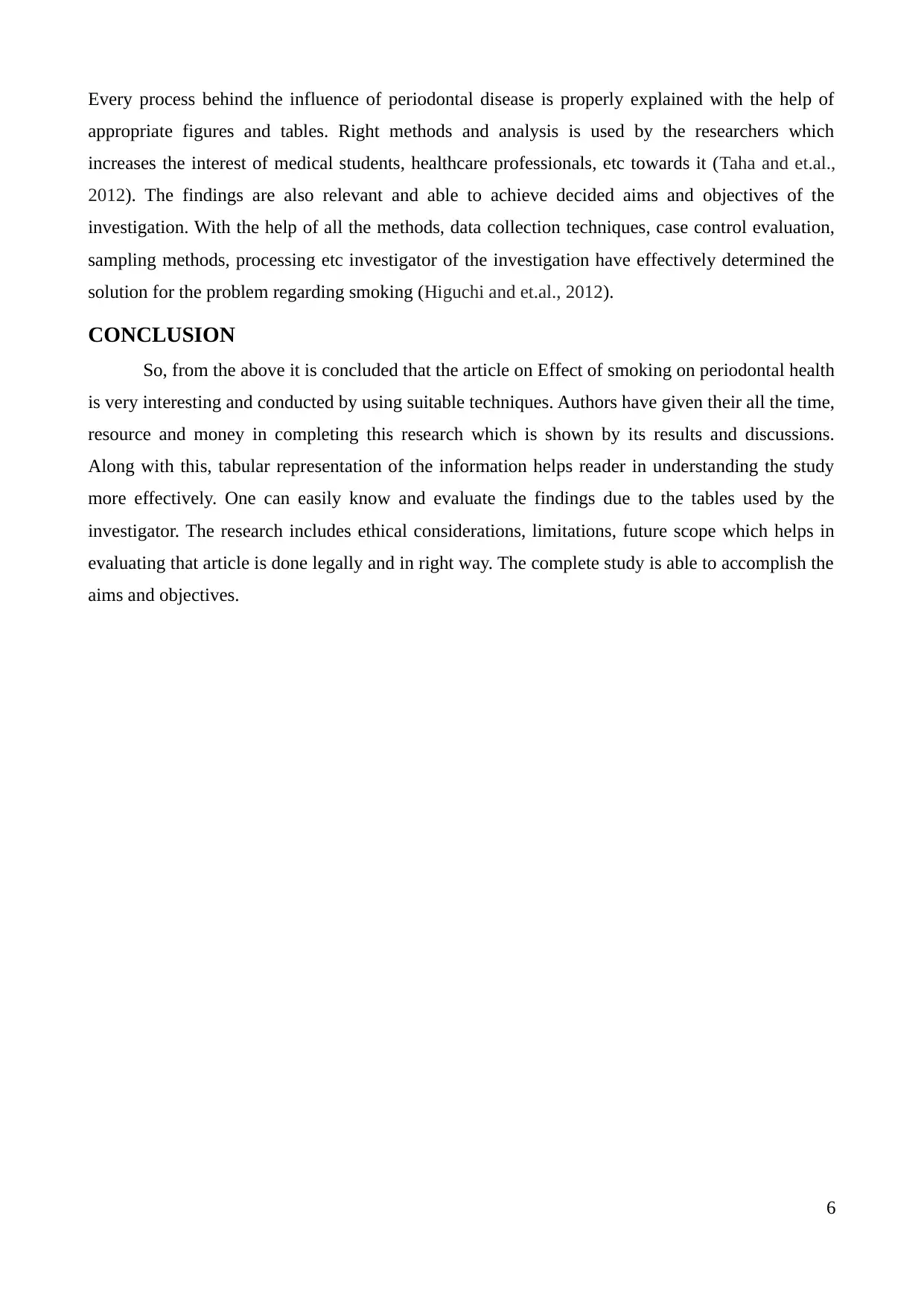
Every process behind the influence of periodontal disease is properly explained with the help of
appropriate figures and tables. Right methods and analysis is used by the researchers which
increases the interest of medical students, healthcare professionals, etc towards it (Taha and et.al.,
2012). The findings are also relevant and able to achieve decided aims and objectives of the
investigation. With the help of all the methods, data collection techniques, case control evaluation,
sampling methods, processing etc investigator of the investigation have effectively determined the
solution for the problem regarding smoking (Higuchi and et.al., 2012).
CONCLUSION
So, from the above it is concluded that the article on Effect of smoking on periodontal health
is very interesting and conducted by using suitable techniques. Authors have given their all the time,
resource and money in completing this research which is shown by its results and discussions.
Along with this, tabular representation of the information helps reader in understanding the study
more effectively. One can easily know and evaluate the findings due to the tables used by the
investigator. The research includes ethical considerations, limitations, future scope which helps in
evaluating that article is done legally and in right way. The complete study is able to accomplish the
aims and objectives.
6
appropriate figures and tables. Right methods and analysis is used by the researchers which
increases the interest of medical students, healthcare professionals, etc towards it (Taha and et.al.,
2012). The findings are also relevant and able to achieve decided aims and objectives of the
investigation. With the help of all the methods, data collection techniques, case control evaluation,
sampling methods, processing etc investigator of the investigation have effectively determined the
solution for the problem regarding smoking (Higuchi and et.al., 2012).
CONCLUSION
So, from the above it is concluded that the article on Effect of smoking on periodontal health
is very interesting and conducted by using suitable techniques. Authors have given their all the time,
resource and money in completing this research which is shown by its results and discussions.
Along with this, tabular representation of the information helps reader in understanding the study
more effectively. One can easily know and evaluate the findings due to the tables used by the
investigator. The research includes ethical considerations, limitations, future scope which helps in
evaluating that article is done legally and in right way. The complete study is able to accomplish the
aims and objectives.
6
⊘ This is a preview!⊘
Do you want full access?
Subscribe today to unlock all pages.

Trusted by 1+ million students worldwide
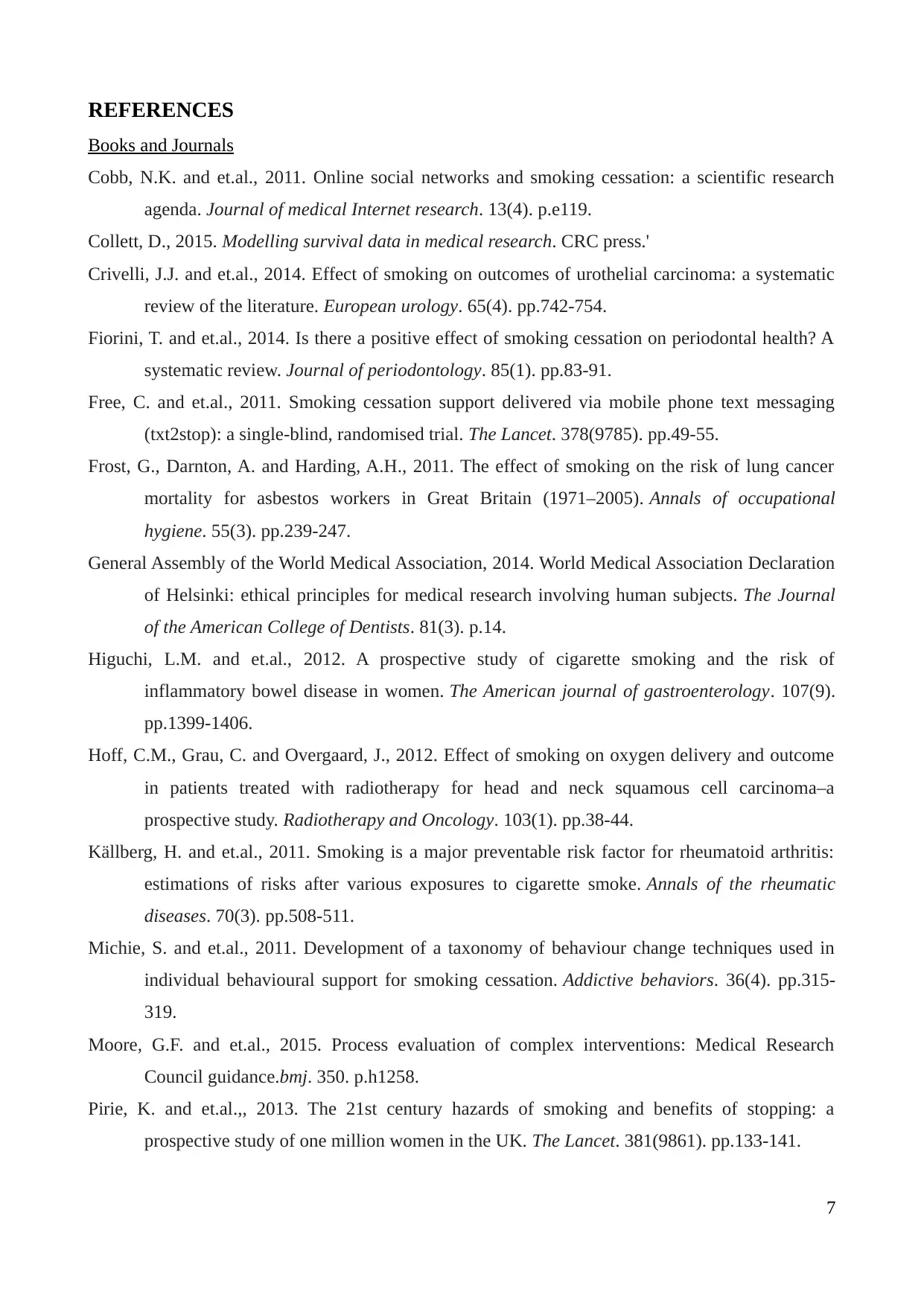
REFERENCES
Books and Journals
Cobb, N.K. and et.al., 2011. Online social networks and smoking cessation: a scientific research
agenda. Journal of medical Internet research. 13(4). p.e119.
Collett, D., 2015. Modelling survival data in medical research. CRC press.'
Crivelli, J.J. and et.al., 2014. Effect of smoking on outcomes of urothelial carcinoma: a systematic
review of the literature. European urology. 65(4). pp.742-754.
Fiorini, T. and et.al., 2014. Is there a positive effect of smoking cessation on periodontal health? A
systematic review. Journal of periodontology. 85(1). pp.83-91.
Free, C. and et.al., 2011. Smoking cessation support delivered via mobile phone text messaging
(txt2stop): a single-blind, randomised trial. The Lancet. 378(9785). pp.49-55.
Frost, G., Darnton, A. and Harding, A.H., 2011. The effect of smoking on the risk of lung cancer
mortality for asbestos workers in Great Britain (1971–2005). Annals of occupational
hygiene. 55(3). pp.239-247.
General Assembly of the World Medical Association, 2014. World Medical Association Declaration
of Helsinki: ethical principles for medical research involving human subjects. The Journal
of the American College of Dentists. 81(3). p.14.
Higuchi, L.M. and et.al., 2012. A prospective study of cigarette smoking and the risk of
inflammatory bowel disease in women. The American journal of gastroenterology. 107(9).
pp.1399-1406.
Hoff, C.M., Grau, C. and Overgaard, J., 2012. Effect of smoking on oxygen delivery and outcome
in patients treated with radiotherapy for head and neck squamous cell carcinoma–a
prospective study. Radiotherapy and Oncology. 103(1). pp.38-44.
Källberg, H. and et.al., 2011. Smoking is a major preventable risk factor for rheumatoid arthritis:
estimations of risks after various exposures to cigarette smoke. Annals of the rheumatic
diseases. 70(3). pp.508-511.
Michie, S. and et.al., 2011. Development of a taxonomy of behaviour change techniques used in
individual behavioural support for smoking cessation. Addictive behaviors. 36(4). pp.315-
319.
Moore, G.F. and et.al., 2015. Process evaluation of complex interventions: Medical Research
Council guidance.bmj. 350. p.h1258.
Pirie, K. and et.al.,, 2013. The 21st century hazards of smoking and benefits of stopping: a
prospective study of one million women in the UK. The Lancet. 381(9861). pp.133-141.
7
Books and Journals
Cobb, N.K. and et.al., 2011. Online social networks and smoking cessation: a scientific research
agenda. Journal of medical Internet research. 13(4). p.e119.
Collett, D., 2015. Modelling survival data in medical research. CRC press.'
Crivelli, J.J. and et.al., 2014. Effect of smoking on outcomes of urothelial carcinoma: a systematic
review of the literature. European urology. 65(4). pp.742-754.
Fiorini, T. and et.al., 2014. Is there a positive effect of smoking cessation on periodontal health? A
systematic review. Journal of periodontology. 85(1). pp.83-91.
Free, C. and et.al., 2011. Smoking cessation support delivered via mobile phone text messaging
(txt2stop): a single-blind, randomised trial. The Lancet. 378(9785). pp.49-55.
Frost, G., Darnton, A. and Harding, A.H., 2011. The effect of smoking on the risk of lung cancer
mortality for asbestos workers in Great Britain (1971–2005). Annals of occupational
hygiene. 55(3). pp.239-247.
General Assembly of the World Medical Association, 2014. World Medical Association Declaration
of Helsinki: ethical principles for medical research involving human subjects. The Journal
of the American College of Dentists. 81(3). p.14.
Higuchi, L.M. and et.al., 2012. A prospective study of cigarette smoking and the risk of
inflammatory bowel disease in women. The American journal of gastroenterology. 107(9).
pp.1399-1406.
Hoff, C.M., Grau, C. and Overgaard, J., 2012. Effect of smoking on oxygen delivery and outcome
in patients treated with radiotherapy for head and neck squamous cell carcinoma–a
prospective study. Radiotherapy and Oncology. 103(1). pp.38-44.
Källberg, H. and et.al., 2011. Smoking is a major preventable risk factor for rheumatoid arthritis:
estimations of risks after various exposures to cigarette smoke. Annals of the rheumatic
diseases. 70(3). pp.508-511.
Michie, S. and et.al., 2011. Development of a taxonomy of behaviour change techniques used in
individual behavioural support for smoking cessation. Addictive behaviors. 36(4). pp.315-
319.
Moore, G.F. and et.al., 2015. Process evaluation of complex interventions: Medical Research
Council guidance.bmj. 350. p.h1258.
Pirie, K. and et.al.,, 2013. The 21st century hazards of smoking and benefits of stopping: a
prospective study of one million women in the UK. The Lancet. 381(9861). pp.133-141.
7
Paraphrase This Document
Need a fresh take? Get an instant paraphrase of this document with our AI Paraphraser

Taha, E.A. and et.al., 2012. Effect of smoking on sperm vitality, DNA integrity, seminal oxidative
stress, zinc in fertile men. Urology. 80(4). pp.822-825.
Whittaker, R. and et.al., 2011. A theory-based video messaging mobile phone intervention for
smoking cessation: randomized controlled trial. Journal of Medical Internet Research.
13(1). p.e10.
8
stress, zinc in fertile men. Urology. 80(4). pp.822-825.
Whittaker, R. and et.al., 2011. A theory-based video messaging mobile phone intervention for
smoking cessation: randomized controlled trial. Journal of Medical Internet Research.
13(1). p.e10.
8
1 out of 8
Related Documents
Your All-in-One AI-Powered Toolkit for Academic Success.
+13062052269
info@desklib.com
Available 24*7 on WhatsApp / Email
![[object Object]](/_next/static/media/star-bottom.7253800d.svg)
Unlock your academic potential
Copyright © 2020–2025 A2Z Services. All Rights Reserved. Developed and managed by ZUCOL.




